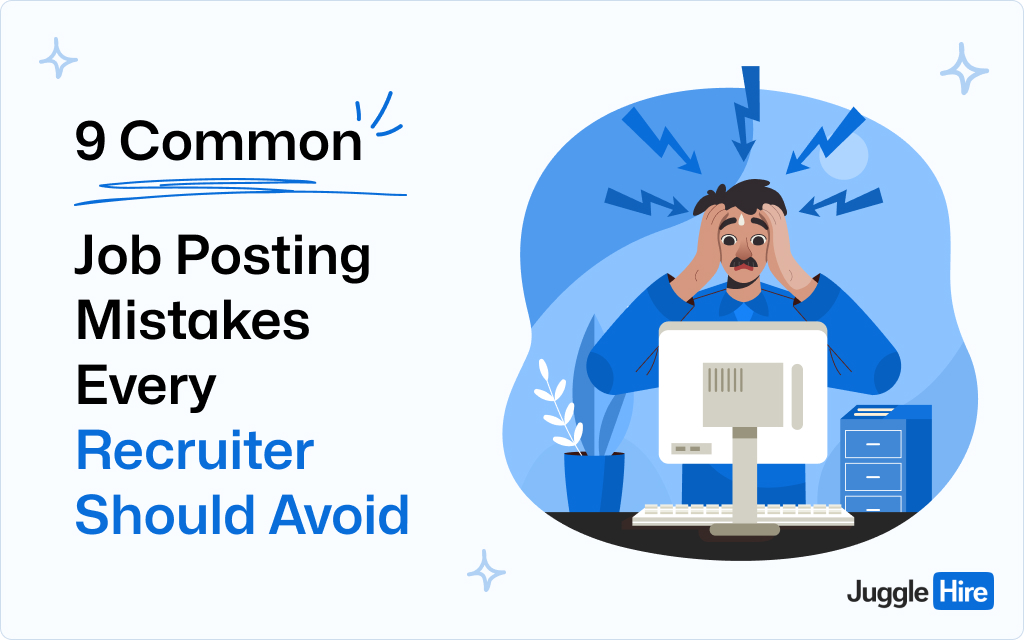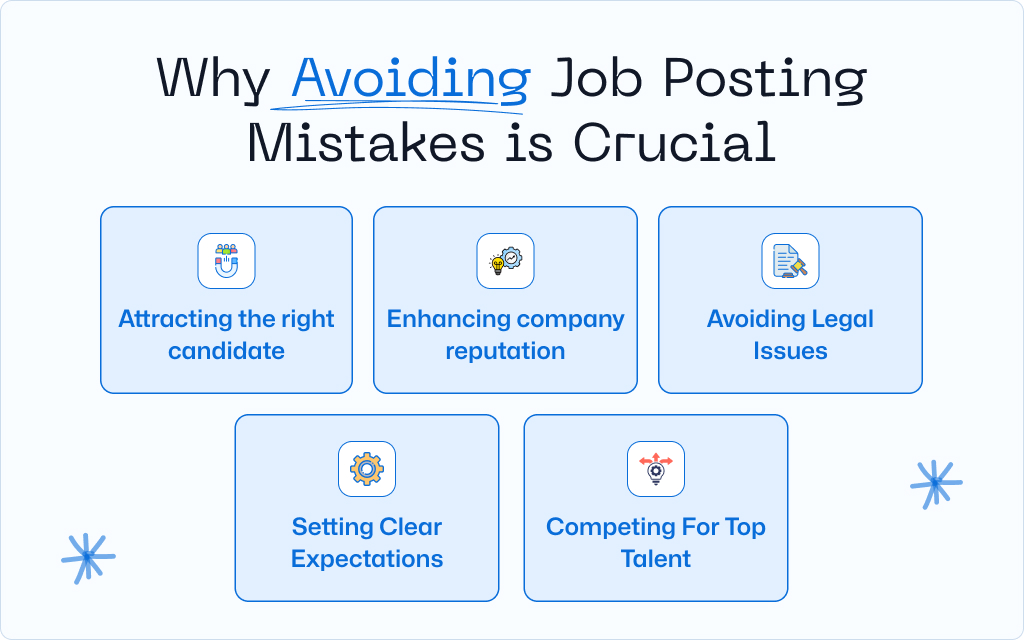9 Common Job Posting Mistakes Every Recruiter Should Avoid

Hiring the right talent is crucial for the success of your business, and so is creating an effective job posting.
A well-crafted job post can make all the difference in ensuring that you have a successful recruitment process and also attracting the right candidates into your organization.
Many recruiters make mistakes that deter skilled candidates and complicate the hiring process. These errors can lead to a longer recruitment cycle and may even damage your company’s reputation.
To help you avoid these pitfalls, we’ve identified 9 common job posting mistakes that every recruiter should be aware of. By understanding these issues, you can attract top talent more efficiently and ensure your recruitment efforts are successful.
Why Avoiding Job Posting Mistakes is Crucial

Avoiding common job posting mistakes is crucial for several reasons. Crafting the right job advertisement plays a critical role in shaping the perception of your company.
Here are some key reasons why every detail in your job posting matters:
I) Attracting the Right Candidates
Firstly, clear and accurate job descriptions attract the right candidates. When you create a job posting with all the necessary details, it helps potential applicants understand the role and assess if their skills match the job requirements. This reduces the number of unqualified applicants, saving you time during the hiring process.
II) Enhancing Company Reputation
Secondly, well-crafted job postings increase your company’s reputation. Companies that provide detailed and error-free job advertisements are perceived as professional and trustworthy. This perception helps attract more skilled and experienced candidates.
In contrast, job postings with errors or vague descriptions can deter potential applicants. It can lead them to question your company’s credibility.
IV) Avoiding Legal Issues
Additionally, avoiding mistakes in job postings can prevent potential legal issues. You must use accurate and non-discriminatory language to comply with employment laws. For example, job postings should not include gender-specific terms or age-related requirements unless they are legally justified. Ensuring compliance helps avoid legal penalties and protects your company’s image.
V) Setting Clear Expectations
Correct information in job postings sets clear expectations right from the start. It ensures that candidates understand the job scope, required qualifications, and responsibilities. This clarity helps in aligning expectations and reduces turnover, as employees have a precise understanding of what their job entails.
VI) Competing for Top Talent
Lastly, effective job postings are essential for competitive positioning in the job market. They need to stand out and appeal to top talent. A well-written job description that clearly outlines benefits, company culture, and growth opportunities can make a significant difference in attracting high-quality candidates.
9 Common Job Posting Mistakes Every Recruiter Should Avoid

Creating an effective job posting is crucial for attracting the right candidates to your open positions. However, there are common mistakes that recruiters often make which can hinder the process and reduce the quality of applications received.
Here, we outline nine common job posting mistakes to avoid in order to ensure your job postings are clear, appealing, and effective in drawing in the best talent.
Mistake 1: Unclear Job Titles
Using unclear job titles can confuse potential candidates. It’s important to choose job titles that accurately reflect the role. Avoid titles that are too broad or too niche. For example, instead of using a vague title like “Sales Wizard,” use “Sales Representative.” This specific title clearly communicates the job’s nature without confusion.
When candidates search for jobs, they use common industry-specific terms. If your job title is straightforward, it’s more likely that the right candidates will find your job posting. This helps you attract applicants who truly fit the job, rather than those confused by an unconventional title.
Mistake 2: Overly Complicated or Vague Job Descriptions
Job descriptions that are too complex or too vague can deter qualified candidates. Your job description should clearly outline what the job entails and what qualifications are necessary. Avoid using long paragraphs without clear information.
For example, if you’re hiring a Project Manager, state specific duties like “Responsible for overseeing project timelines and budget.” Vague descriptions such as “handle various project aspects” are not helpful and can lead to applications from candidates who do not truly understand or are unqualified for the role.
A precise job description ensures that applicants know exactly what is expected and whether they meet the requirements.
Mistake 3: Overloaded with Jargon and Buzzwords
Using too much jargon or too many buzzwords can alienate potential applicants who might not understand them. This is another one of the common job posting mistakes that can make your job posting seem exclusive or pretentious.
For instance, a job posting for a digital marketer that says “seeking a ninja in viral paradigm shifts and thought leadership” can be confusing. Instead, use clear language like “experienced in social media marketing and leading innovative campaigns.”
This makes the role accessible to more people and ensures that applicants understand the job’s requirements without needing to decode complex terminology.
Clear language helps attract a broader, more diverse pool of qualified candidates.
Also Read: Remote Hiring Tips: How To Attract, Hire and Retain Remote Employees
Mistake 4: Lack of Essential Details
A job posting should always include essential details such as the location of the job, salary range, type of employment (full-time, part-time, contract), and any benefits associated with the role.
When these details are missing, potential candidates may not bother applying because they don’t have enough information to determine if the job fits their needs.
For instance, if a job posting for a graphic designer does not specify that the position is remote, candidates looking specifically for remote opportunities might overlook the job.
Including specific details ensures that the candidates who apply are genuinely interested in the offer as presented, which saves time in the recruitment process.
Mistake 5: Unrealistic or Unclear Qualifications
When job qualifications are unrealistic or not clearly defined, it discourages qualified individuals from applying and attracts unqualified candidates. This another one of the common job posting mistakes. It’s crucial to list qualifications that are necessary and realistic for the job.
For example, demanding over 10 years of experience for a mid-level engineering position might deter potentially perfect candidates with 5-7 years of relevant, intensive experience.
Instead, specify essential qualifications and distinguish them from desired but not mandatory skills. This clarity helps potential applicants self-assess their suitability more accurately and encourages a wider range of qualified candidates to apply.
Mistake 6: Not Highlighting Company Culture
Failing to highlight your company’s culture can result in a mismatch between what the candidate expects and the reality of working at your company.
It’s important to convey the work environment, values, and any unique attributes of your company culture in your job posting.
For example, if your company highly values collaboration and has an open office layout, mention this in the job posting. This attracts candidates who thrive in collaborative settings and value transparency and teamwork.
Sharing this information helps attract candidates who are more likely to fit in and be satisfied with your company’s environment, leading to higher retention rates.
Mistake 7: Failure to Mention Salary Range
Not mentioning the salary range in a job posting can lead to a lack of applications from interested and qualified candidates. Many potential applicants look for salary information to determine if the job meets their financial needs before applying.
For example, a job posting for an Account Manager should state the expected salary range, such as “$50,000 to $70,000 annually, based on experience.”
By providing this information, you attract candidates who are comfortable with the offered salary, which reduces time spent negotiating salaries later in the hiring process and sets clear expectations from the start.
Mistake 8: Failing to Mention Application Process and Timeline
When job postings do not include details about the application process and timeline, candidates may be unsure when or how to apply, or when they can expect a response. It’s important to give specific instructions and timelines.
For instance, if you’re hiring for a customer service role, the job posting might say, “Please submit your resume and a cover letter by May 30. Selected candidates will be contacted by June 15 for interviews.”
This keeps candidates informed about the selection process and helps manage their expectations, ensuring a smoother recruitment process.
Mistake 9: Ineffective Call to Action
An ineffective call to action in a job posting can result in low applicant response rates. Your call to action should be clear, compelling, and direct. It should encourage candidates to apply immediately.
For example, rather than ending a job posting with a vague statement like “Interested candidates may consider applying,” use a more direct and engaging approach such as, “Apply now to join our innovative team!”
This clear instruction motivates candidates to take action immediately, increasing the number of applications and improving the chances of finding the right candidate sooner.
Job Posting Mistakes – Ending Note
In conclusion, creating a clear and effective job posting is essential for attracting the right candidates and streamlining your recruitment process. By avoiding common job posting mistakes such as unclear job titles, overly complicated descriptions, and failing to provide essential details like salary ranges, you can enhance the effectiveness of your job ads.
Remember, a well-crafted job posting not only saves time and resources but also boosts your company’s image as a great place to work. Take the time to review your job postings for these common errors and you’ll likely see a higher quality of applicants and a smoother hiring process.
